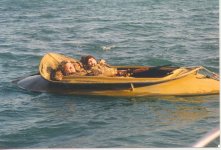I give Lou 100% credit for this idea which I've used very successfully over the past seven seasons. Don't bother with it in every situation because it isn't needed. As Lou will tell you, this trick only needs to be pulled out when the layout is the wrong color for the water or day, or the birds are flaring (back to reason 1).
First, use the thickest construction grade visqueen you can find. Can't remember the exact mil I use (got a roll ready to go up north), but it is very thick and takes a noticable price jump for this grade. Don't cheap out on this part if you want it to work well and last more than one outing. The good stuff almost looks more translucent white than clear.
The number one problem I have encountered using visqueen dozens of times is controling it in the wind. You better have a plan for keeping it under wraps when the breeze kicks up or else give your buddy a video camera to record the comedy. It's like a light weight sail that catches every gust of wind and will fly out of shape constantly if it isn't buttoned down. Especially in the cockpit area where wind wants to slide under the plastic and balloon up over the deck of the boat. Some use decoy weights, but I like something heavier such as two pound lead trolling sinkers. Forget the exact number, but it's something like ten of them all around the perimeter. I use those two part plastic gromets for tarps and fold the visqueen over for double bite where it will be under water. This way the plastic won't tear where you have the weights tied to it. I used to use decoy cord, but now have upgraded to 300 pound mono and aluminum crimps I have on hand for texas rigging. This will hold the visqueen down around the edges and with the gromets last an entire season or more.
The biggest wear factor is ripping in the corners where you cut out for the cockpit. I reinforce these areas on the UNDERSIDE with duct tape. Trust me, the ducks won't care about the tan color of the sticky part of duct tape under the plastic. By the time they even have a chance to even notice it under the water like glare of the visqueen they are dead. The good news is this will make those cut out corners last much longer.
Keeping the plastic from ballooning when wind enters in the cockpit is another challenge. I've used several methods including large metal clips from office supply stores spray painted grey to black plastic clips from Harbor Freight. None of them are perfect and they all pop off at times when getting in and out of the boat. Just buy a lot of them and keep that wind from getting under the plastic in the cockpit area.
BTW, that reminds me of another tip. WHen you cut the visqueen for the cockpit cut out leave it the full length of the opening and completely attached toward your feet. That way a hunter can pull the visqueen over himself like a blanket for the ultimate open water camo. I often tuck it under my chin to keep the wind from blowing it and allowing both hands to be free.
It's a pain in the arse, but very worthwhile when birds that wouldn't come in minutes before are darn near landing on top of you!
Thanks Lou.......



